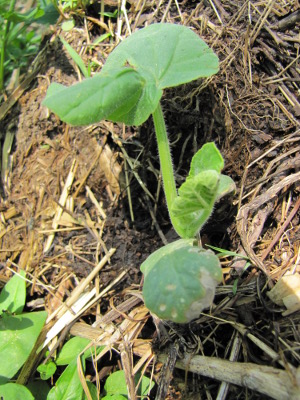
Compost pile volunteers
 This butternut seedling is
growing on the compost pile...along with a few dozen of his brothers
and cousins. Whenever I walk by, I can't help but think about the
anthropological hypothesis that agriculture may have begun when seeds
like this sprouted out of early man's midden heaps.
This butternut seedling is
growing on the compost pile...along with a few dozen of his brothers
and cousins. Whenever I walk by, I can't help but think about the
anthropological hypothesis that agriculture may have begun when seeds
like this sprouted out of early man's midden heaps.
If you pay attention,
you'll notice that some vegetables can put up with compost piles while
others can't. At first, compost life sounds like living on easy
street, but the conditions are actually a bit rough. Sure,
there's plenty of extra fertility, but my volunteer butternuts have had
to put up with undiluted
urine baths a couple
of times a week, with lots of high carbon materials to grow around, and
with shifting soil as the compost pile settles. Despite these
potential problems, volunteer tomatoes and squashes seem to prefer the
compost heap to the garden.
When you create
a kill mulch and
plant into it right away rather than letting the no-till garden mellow
for a season before planting, you're growing in soil a lot like your
compost pile. That's why I save crops that make good compost pile
volunteers for our new no-till beds each summer, and give less hearty
garden crops the older beds. Now I just have to decide whether to
let thirty butternut plants sprawl out across the forest pasture or to
turn the compost pile and crush these volunteers.
Want more in-depth information? Browse through our books.
Or explore more posts by date or by subject.
About us: Anna Hess and Mark Hamilton spent over a decade living self-sufficiently in the mountains of Virginia before moving north to start over from scratch in the foothills of Ohio. They've experimented with permaculture, no-till gardening, trailersteading, home-based microbusinesses and much more, writing about their adventures in both blogs and books.
Want to be notified when new comments are posted on this page? Click on the RSS button after you add a comment to subscribe to the comment feed, or simply check the box beside "email replies to me" while writing your comment.
- Remove comment
- Remove comment
- Remove comment
- Remove comment

- Remove comment
 That's something we definitely don't have to deal with. The problem here is how to hold back from planting all 58 acres and wearing our fingers to the bone.
That's something we definitely don't have to deal with. The problem here is how to hold back from planting all 58 acres and wearing our fingers to the bone.
- Remove comment
